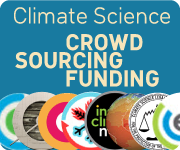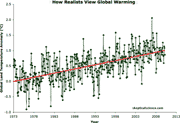Skeptical Science New Research for Week #6 2025
Posted on 6 February 2025 by Doug Bostrom, Marc Kodack
Open access notables
Doing better rather than promising more: A basic principle applicable to both climate modelling and climate policies, Douville, PLOS Climate:
A growing number of scientists are expressing concerns about the inadequacy of climate change policies. Fewer are questionning the dominant climate modelling paradigm and the IPCC’s success to prevent humanity from venturing unprepared into hitherto unknown territories. However, in view of an urgent need to provide readily available data on constraining uncertainty in local and regional climate change impacts in the next few years, there is a debate on the most suitable path to inform both mitigation and adaptation strategies. Examples are given how both common statistical methods and emerging technologies can be readily used to exploit the wealth of existing knowledge to drive adaptation policy. Parsimonious and equitable approaches on constraining uncertainty are promoted that combine various lines of evidence, including model diversity, large ensembles, storylines, and novel statistical methods applied on well-calibrated, global and regional, Earth System simulations, to deliver more reliable climate information. As examplified by the Paris agreement on desirable global warming targets, it is argued that the display of unrealistic ambitions may not be the best way for climate modellers to accomplish their long-term objectives, especially given the growing consensus on climate emergency and the allocated short time for the knowledge to be delivered and applied.
Mortality impacts of the most extreme heat events, Matthews et al., Nature Reviews Earth & Environment
In this Review, we link physical climate science with heat mortality risk, including crossings of uncompensable thresholds (beyond which human core body temperature rises uncontrollably) and unsurvivable thresholds (lethal core temperature increase within 6 h). Uncompensable thresholds (wet-bulb temperatures ~19–32 °C) depend strongly on age and the combination of air temperature and relative humidity. These thresholds have been breached rarely for younger adults (~2.2% of land area over 1994–2023) but more widely for older adults (~21%). Unsurvivable thresholds (wet-bulb temperatures ~20–34 °C) were only exceeded for older adults (~1.8% of land area). Anthropogenic warming will lead to more frequent threshold crossings, including tripling of the uncompensable land area for young adults if warming reaches 2 °C above preindustrial levels. Interdisciplinary work must improve the understanding of the deadly potential of unprecedented heat and how it can be reduced. Ensuring reliable access for all to cool refugia is an urgent priority as the atmosphere threatens to increasingly overwhelm human physiology under climate warming.
Global water gaps under future warming levels, Rosa & Sangiorgio, Nature Communications:
Understanding the impacts of climate change on water resources is crucial for developing effective adaptation strategies. We quantify “water gaps”, or unsustainable water use – the shortfall where water demand exceeds supply, resulting in scarcity. We quantify baseline and future water gaps using a multi-model analysis that incorporates two plausible future warming scenarios. The baseline global water gap stands at 457.9 km3/yr, with projections indicating an increase of 26.5 km3/yr (+5.8%) and 67.4 km3/yr (+14.7%) under 1.5 °C and 3 °C warming scenarios, respectively. These projections highlight the uneven impact of warming levels on water gaps, emphasizing the need for continued climate change mitigation to alleviate stress on water resources. Our results also underscore the unequal adaptation needs across countries and basins, influenced by varying warming scenarios, with important regional differences and model variability complicating future projections. Robust water management strategies are needed to tackle the escalating water scarcity caused by global warming.
Email outreach attracts the US policymakers’ attention to climate change but common advocacy techniques do not improve engagement, Loria et al., Communications Earth & Environment:
One of the most challenging aspects of climate change mitigation today is not identifying solutions but reaching political leaders with climate scientists’ existing solutions. Although there is substantial research on climate change communication, research rarely focuses on one of the most impactful groups: policymakers. It is essential to test theoretically sound methods to increase lawmakers’ attention to research evidence. In a series of four rapid-cycle randomized controlled email trials (N = 6642–7620 per trial), we test three common and theoretically derived advocacy tactics to increase U.S. policymaker engagement with a climate change fact sheet sent via email (i.e., a norms manipulation, a number focused manipulation, and emotional language manipulation). In all four trials, the control message increased engagement more than messages using advocacy tactics, measured by fact sheet clicks. This demonstrates the importance of testing communication methods within the appropriate populations, especially a population with considerable influence over climate policy.
Calculations of extreme sea level rise scenarios are strongly dependent on ice sheet model resolution, Williams et al., Communications Earth & Environment:
The West Antarctic Ice Sheet (WAIS) is losing ice and its annual contribution to sea level is increasing. The future behaviour of WAIS will impact societies worldwide, yet deep uncertainty remains in the expected rate of ice loss. High-impact low-likelihood scenarios of sea-level rise are needed by risk-averse stakeholders but are particularly difficult to constrain. Here, we combine traditional model simulations of the Amundsen Sea sector of WAIS with Gaussian process emulation to show that ice-sheet models capable of resolving kilometre-scale basal topography will be needed to assess the probability of extreme scenarios of sea-level rise. This resolution exceeds many state-of-the-art continent-scale simulations. Our ice-sheet model simulations show that coarser resolutions tend to project a larger range of sea-level contributions than finer resolutions, inflating the tails of the distribution. We therefore caution against relying purely upon simulations 5 km or coarser when assessing the potential for societally important high-impact sea-level rise.
Increased crevassing across accelerating Greenland Ice Sheet margins, Chudley et al., Nature Geoscience:
Here we use high-resolution digital elevation models to map the three-dimensional volume of crevasse fields across the Greenland Ice Sheet in 2016 and 2021. We show that, between the two years, large and significant increases in crevasse volume occurred at marine-terminating sectors with accelerating flow (up to +25.3 ± 10.1% in the southeast sector), while the change in total ice-sheet-wide crevasse volume was within measurement error (+4.3 ± 5.9%). The sectoral increases were offset by a reduction in crevasse volume in the central west sector (−14.2 ± 3.2%), particularly at Sermeq Kujalleq (Jakobshavn Isbræ), which exhibited slowdown and thickening over the study period. Changes in crevasse volume correlate strongly with antecedent discharge changes, indicating that the acceleration of ice flow in Greenland forces significant increases in crevassing on a timescale of less than five years. This response provides a mechanism for mass-loss-promoting feedbacks on sub-decadal timescales, including increased calving, faster flow and accelerated water transfer to the bed.
From this week's government/NGO section:
Drill, Baby, Drill? The Well of Public Opinion Is Drying Up on Trump’s Climate Policy, Eva Brungard, Data for Progress
In response to Trump’s reversal of federal climate policy, the author surveyed likely voters about their opinion of Trump’s executive orders and support for fossil fuels versus renewable energy. The findings reveal little support for the shift in energy policy, with the majority of voters hoping to preserve existing climate policies and to continue to develop renewables. Overall, an overwhelming majority (70%) of voters support taking action to address climate change. This includes a majority of both Republicans (54%) and Independents (74%). The highest support is among young voters (81%) – those under 35 – and Democrats (87%). Majorities across every demographic group tested support taking action to address climate change.
Climate Change in the American Mind: Politics & Policy, Fall 2024, Leiserowitz et al., Yale University and George Mason University
Drawing on a representative sample of the U.S. adult population (n = 1,013; including the 890 registered voters whose data are used), these findings describe how registered voters view a variety of domestic climate and energy policies. The survey was conducted from December 11 – 22, 2024, after the 2024 U.S. Presidential election. 54% of registered voters think global warming should be a high or very high priority for the president and Congress. 63% of registered voters think developing sources of clean energy should be a high or very high priority for the president and Congress. Majorities of registered voters support a range of policies to reduce carbon pollution and promote clean energy such as 88% support federal funding to help farmers improve practices to protect and restore the soil so it absorbs and stores more carbon, 67% support requiring fossil fuel companies to pay a carbon tax and using the money to reduce other taxes by an equal amount and 63% support transitioning the U.S. economy from fossil fuels to 100% clean energy by 2050.
136 articles in 56 journals by 741 contributing authors
Physical science of climate change, effects
Dynamics of salt intrusion in complex estuarine networks: an idealised model applied to the Rhine–Meuse Delta, Biemond et al., Ocean Science Open Access 10.5194/os-21-261-2025
Moist convective scaling: Insights from an idealised model, Agasthya et al., Quarterly Journal of the Royal Meteorological Society Open Access 10.1002/qj.4902
Sensitivity of the Energy Conversion Efficiency of Tropical Cyclones During Intensification to Sea Surface Temperature and Static Stability, Lai & Toumi, Quarterly Journal of the Royal Meteorological Society Open Access pdf 10.1002/qj.4895
The emergence of a dipole-like mode in Arctic atmospheric circulation conducive to European heat waves, Lee et al., Communications Earth & Environment Open Access 10.1038/s43247-025-02020-x
The Net Radiative Effect of the Ill-Defined Clear-Sky in the Vicinity of Clouds, Eytan et al., AGU Advances Open Access 10.1029/2024av001407
Observations of climate change, effects
Hemispheric asymmetry in recent stratospheric age of air changes, Dubé et al., Atmospheric Chemistry and Physics Open Access 10.5194/acp-25-1433-2025
Long-term changes in the thermodynamic structure of the lowermost stratosphere inferred from reanalysis data, Weyland et al., Atmospheric Chemistry and Physics Open Access 10.5194/acp-25-1227-2025
Recent Trends in Extreme Temperature Events Across the Contiguous United States, Ibebuchi et al., International Journal of Climatology 10.1002/joc.8693
Significant greening in the western Tibetan Plateau and surroundings occurred after the 1970s, Huang et al., Communications Earth & Environment Open Access 10.1038/s43247-025-02061-2
South European Heatwaves and Their Impacts on the Power System in 2022, Xu et al., Journal of Geophysical Research: Atmospheres Open Access 10.1029/2024jd042310
The southward shift of hurricane genesis over the northern Atlantic Ocean, Cao et al., npj Climate and Atmospheric Science Open Access 10.1038/s41612-025-00923-2
Instrumentation & observational methods of climate change, effects
A generalized extreme value approach for the analysis of stationary climatic covariate in a Mediterranean city, Semia, Atmospheric Science Letters Open Access 10.1002/asl.1291
Data-driven upper bounds and event attribution for unprecedented heatwaves, Risser et al., Weather and Climate Extremes Open Access pdf 10.1016/j.wace.2025.100743
Intraseasonal Air Temperature Variability and Its Trends Are Sensitive to the Definition of Daily Mean Temperature: Germany as a Case Study, Krauskopf & Huth, Journal of Applied Meteorology and Climatology 10.1175/jamc-d-24-0153.1
Near-surface permafrost extent and active layer thickness characterized by reanalysis/assimilation data, Liu et al., Atmospheric Science Letters Open Access 10.1002/asl.1289
Modeling, simulation & projection of climate change, effects
Enhanced Simulation of Atmospheric Blocking in a High-Resolution Earth System Model: Projected Changes and Implications for Extreme Weather Events, Gao et al., Journal of Geophysical Research: Atmospheres 10.1029/2024jd042045
Observed Variability and Future Projections of Urban Heatwaves in Romania, Cheval et al., International Journal of Climatology Open Access pdf 10.1002/joc.8714
The Role of Anthropogenic Climate Change on March–April–May (MAM) Drought Trends Across Global Land, Yohannes et al., International Journal of Climatology 10.1002/joc.8776
Advancement of climate & climate effects modeling, simulation & projection
A Scheme of Sea Surface Upward Longwave Radiation With Sea Spray Layer Effect, Jing et al., Journal of Geophysical Research: Oceans Open Access 10.1029/2024jc021721
An improved and extended parameterization of the CO2 15 µm cooling in the middle and upper atmosphere (CO2&cool&fort-1.0), López-Puertas et al., Geoscientific Model Development Open Access 10.5194/gmd-17-4401-2024
Assessing Annual and Monthly Precipitation Anomalies in Ecuador Bioregions Using WorldClim CMIP6 GCM Ensemble Projections and Dynamic Time Warping, Santos et al., International Journal of Climatology 10.1002/joc.8685
Mechanisms in Regulating the Quasi-Biennial Oscillation in Exascale Earth System Model Version 2, Li et al., Journal of Geophysical Research: Atmospheres 10.1029/2024jd041868
Reproducibility of local cold-season characteristics, ice episodes, and prevailing circulation patterns in regional climate models, Bell et al., Quarterly Journal of the Royal Meteorological Society Open Access 10.1002/qj.4881
Resolution dependence of the turbulent atmospheric boundary layer in global storm-resolving climate simulations, Huusko et al., Quarterly Journal of the Royal Meteorological Society Open Access 10.1002/qj.4940
Spatial and temporal dependence in distribution-based evaluation of CMIP6 daily maximum temperatures, Virdee et al., Atmospheric Science Letters Open Access 10.1002/asl.1290
Technical note: Recommendations for diagnosing cloud feedbacks and rapid cloud adjustments using cloud radiative kernels, Zelinka et al., Atmospheric Chemistry and Physics Open Access 10.5194/acp-25-1477-2025
Cryosphere & climate change
Historical snow measurements in the central and southern Apennine Mountains: climatology, variability, and trend, Capozzi et al., The Cryosphere Open Access 10.5194/tc-19-565-2025
Increased crevassing across accelerating Greenland Ice Sheet margins, Chudley et al., Nature Geoscience Open Access 10.1038/s41561-024-01636-6
Lateral Fluxes Drive Basal Melting Beneath Thwaites Eastern Ice Shelf, West Antarctica, Davis et al., Geophysical Research Letters Open Access 10.1029/2024gl111873
Sea level & climate change
Calculations of extreme sea level rise scenarios are strongly dependent on ice sheet model resolution, Williams et al., Communications Earth & Environment Open Access 10.1038/s43247-025-02010-z
Variable vertical land motion and its impacts on sea level rise projections, Govorcin et al., Science Advances Open Access 10.1126/sciadv.ads8163
Paleoclimate & paleogeochemistry
Marine species and assemblage change foreshadowed by their thermal bias over Early Jurassic warming, Reddin et al., Nature Communications Open Access 10.1038/s41467-025-56589-0
Biology & climate change, related geochemistry
Climate change aggravates bird mortality in pristine tropical forests, Wolfe et al., Science Advances Open Access 10.1126/sciadv.adq8086
Coastal Marsh Vulnerability to Sea-Level Rise Is Exacerbated by Plant Species Invasion, Wang et al., Global Change Biology 10.1111/gcb.70058
CoralBleachRisk—Global Projections of Coral Bleaching Risk in the 21st Century, Mellin et al., Global Ecology and Biogeography Open Access 10.1111/geb.13955
Decline in plant species richness with a chronic decrease of precipitation: The mediating role of the dominant species, Ónodi et al., Journal of Ecology Open Access 10.1111/1365-2745.14483
Distinct Functioning of Low- Versus High-Altitude Refugia in the Mediterranean: Inferences From Life-History Traits of Two Related Relict Trees From the Islands of Sicily and Crete, Garfì et al., Diversity and Distributions Open Access 10.1111/ddi.13961
Do you remember? Within-generation and transgenerational heat stress memory of recurring marine heatwaves in threespine stickleback, Spence-Jones et al., Proceedings of the Royal Society B: Biological Sciences Open Access 10.1098/rspb.2024.2913
Ensemble modeling of the climate-energy nexus for renewable energy generation across multiple US states, Adul et al., Environmental Research: Infrastructure and Sustainability Open Access 10.1088/2634-4505/adad12
Making hay while the sun shines: Energy security pathway for Africa, Okorie, Energy Policy Open Access 10.1016/j.enpol.2025.114512
Evolution in changing seas: The loss of plasticity under predator invasion and warming oceans, Corbett & Trussell, Science Advances 10.1126/sciadv.adr6947
Global decline in net primary production underestimated by climate models, Ryan-Keogh et al., Communications Earth & Environment Open Access 10.1038/s43247-025-02051-4
Global Projection of Terrestrial Vertebrate Food Webs Under Future Climate and Land-Use Changes, Hao et al., Global Change Biology Open Access pdf 10.1111/gcb.70061
Increasing rat numbers in cities are linked to climate warming, urbanization, and human population, Richardson et al., Science Advances Open Access 10.1126/sciadv.ads6782
Increasing vulnerability of an endemic Mediterranean-climate conifer to changing climate and fire regime, Davis et al., Frontiers in Forests and Global Change Open Access 10.3389/ffgc.2025.1516623
Intraspecific divergence within Microcystis aeruginosa mediates the dynamics of freshwater harmful algal blooms under climate warming scenarios, Kuijpers et al., Proceedings of the Royal Society B: Biological Sciences 10.1098/rspb.2024.2520
Intraspecific Diversity in Thermal Performance Determines Phytoplankton Ecological Niche, Krinos et al., Open Access pdf 10.1101/2024.02.14.580366
Lichens are more tolerant against winter warming stress than vascular and non-vascular plants: Insights from an alpine field experiment, Finne et al., Journal of Ecology Open Access 10.1111/1365-2745.14482
Migratory behaviour of humpback whales in the southeastern Pacific under climate change, Millien et al., Scientific Reports Open Access 10.1038/s41598-025-87489-4
Predicting climate-change impacts on the global glacier-fed stream microbiome, Bourquin et al., Nature Communications Open Access 10.1038/s41467-025-56426-4
Responses of Littorina spp. Intertidal Snails to Thermal Extremes Indicate Countergradient Variation in Fitness, Titmuss et al., Ecology and Evolution Open Access 10.1002/ece3.70926
Systematic shifts in the variation among host individuals must be considered in climate-disease theory, Mihaljevic & Páez Páez, Proceedings of the Royal Society B: Biological Sciences Open Access 10.1098/rspb.2024.2515
The role of climate and species interactions in determining the distribution of two elevationally segregated species of small mammals through time, Coconis et al., Ecography Open Access 10.1111/ecog.07556
Tracking over 30 years of coral reef infrastructure degradation in Barbados, Griffith et al., Scientific Reports Open Access pdf 10.1038/s41598-024-83720-w
Unprecedented Summer Phytoplankton Bloom in the Ross Sea, Portela et al., Geophysical Research Letters Open Access 10.1029/2024gl111264
GHG sources & sinks, flux, related geochemistry
A 1 km soil organic carbon density dataset with depth of 20cm and 100cm from 1985 to 2020 in China, Dong et al., Open Access 10.5194/essd-2024-588
Can We Constrain Geographical Variability in the Biological Carbon Pump's Transfer Efficiency From Observations?, Rufas et al., Geophysical Research Letters Open Access 10.1029/2024gl111203
Dilemmas in Linking Microbial Carbon Use Efficiency With Soil Organic Carbon Dynamics, Zhou et al., Global Change Biology 10.1111/gcb.70047
Improving Carbon Budgets by Accounting for Inorganic Carbon in Seagrass Ecosystems, Ren et al., Global Change Biology 10.1111/gcb.70060
Rising Water Levels and Vegetation Shifts Drive Substantial Reductions in Methane Emissions and Carbon Dioxide Uptake in a Great Lakes Coastal Freshwater Wetland, Tang et al., Global Change Biology Open Access 10.1111/gcb.70053
Spatial and temporal variations of gross primary production simulated by land surface model BCC&AVIM2.0, Li et al., Advances in Climate Change Research Open Access 10.1016/j.accre.2023.02.001
The 2020 Heatwave Led to a Larger Enhancement in Annual Gross Primary Production in West Siberia Than in East Siberia, Park et al., Journal of Geophysical Research: Biogeosciences 10.1029/2024jg008487
Warmer Climate Reduces the Carbon Storage, Stability and Saturation Levels in Forest Soils, Wu et al., Earth's Future Open Access 10.1029/2024ef004988
CO2 capture, sequestration science & engineering
Biotechnology in direct air capture, enhanced weathering, and methane removal: emerging opportunities and gaps, Reginato, Frontiers in Climate Open Access 10.3389/fclim.2024.1440833
Getting the best of carbon bang for mangrove restoration buck, Zhang et al., Nature Communications Open Access 10.1038/s41467-025-56587-2
National climate strategies show inequalities in global development of carbon dioxide geological storage, Alcalde et al., Communications Earth & Environment Open Access 10.1038/s43247-025-02043-4
Decarbonization
Aviation sector decarbonization within the hydrogen economy – A UAE case study, Zubi et al., Energy Policy Open Access pdf 10.1016/j.enpol.2025.114520
Designing EV charging networks from a city perspective: A conceptual analysis, Müller et al., Energy Policy Open Access 10.1016/j.enpol.2025.114516
Ensemble modeling of the climate-energy nexus for renewable energy generation across multiple US states, Adul et al., Environmental Research: Infrastructure and Sustainability Open Access 10.1088/2634-4505/adad12
Making hay while the sun shines: Energy security pathway for Africa, Okorie, Energy Policy Open Access 10.1016/j.enpol.2025.114512
Climate change communications & cognition
Climate Change Is an Intangible News Topic: A Qualitative Analysis of Audience Perceptions, Høegh-Krohn et al., Environmental Communication 10.1080/17524032.2025.2458220
Climate change risks illustrated by the Intergovernmental Panel on Climate Change (IPCC) “burning embers”, Marbaix et al., Earth System Science Data Open Access 10.5194/essd-17-317-2025
Climate Change Versus Economic Growth: Quantifying, Identifying and Comparing Articulations in News Media Using Dynamic Topic Modeling, Mervaala, Environmental Communication Open Access 10.1080/17524032.2025.2458222
Economic Vulnerability and Emotions toward Climate Change: A Case Study of Spain, Fernández et al., Journal of Environmental Psychology Open Access 10.1016/j.jenvp.2025.102537
Email outreach attracts the US policymakers’ attention to climate change but common advocacy techniques do not improve engagement, Loria et al., Communications Earth & Environment Open Access 10.1038/s43247-025-02055-0
Film and Television Production in the Age of Climate Crisis Towards a Greener Screen, Wiranugraha et al., Environmental Communication 10.1080/17524032.2025.2459351
Gaps in climate health literacy: an analysis of Kosovo’s pre-university curricula and textbooks, Ramadani et al., Frontiers in Climate Open Access 10.3389/fclim.2025.1531555
Public Communication of Climate and Justice: A Scoping Review, Tschötschel et al., WIREs Climate Change Open Access 10.1002/wcc.932
Risk science and politics: What is and should be the relationship?, Aven, Risk Analysis Open Access pdf 10.1111/risa.16558
The misperception of carbon footprints of the rich and the poor, Nockur et al., Journal of Environmental Psychology Open Access 10.1016/j.jenvp.2025.102545
Who talks about climate, peace and security? A social media analysis to identify key global actors, Tucci et al., PLOS Climate Open Access 10.1371/journal.pclm.0000502
Agronomy, animal husbundry, food production & climate change
A cost–benefit analysis of the production system with improved and climate-resilient sorghum varieties in southern Mali, Coulibaly et al., Frontiers in Climate Open Access 10.3389/fclim.2024.1477039
Agricultural structure management based on water–energy–food and carbon sink scenarios in typical fuel ethanol raw material planting areas—a case study of the Hulan River Basin, Northeast China, Cui et al., Frontiers in Environmental Science Open Access 10.3389/fenvs.2024.1530694
Interplay Among Recent Trends in Climate Extremes, Vegetation Phenology, and Crop Production in the Southern Mediterranean Region, Mirgol et al., International Journal of Climatology Open Access 10.1002/joc.8768
Modeling biochar effects on soil organic carbon on croplands in a microbial decomposition model (MIMICS-BC&v1.0), Han et al., Geoscientific Model Development Open Access 10.5194/gmd-17-4871-2024
Research progress on climate change adaptation strategies to control invasive crop pest in sub-Saharan Africa: a bibliometric and systematic review, Assèdé et al., Frontiers in Climate Open Access 10.3389/fclim.2025.1478721
The impact of climate change on household dietary diversity in Afghanistan, Yolchi & Wang, Climate Risk Management Open Access 10.1016/j.crm.2025.100687
Traditional ecological knowledge in High Mountain Asia: a pathway to climate resilience in agriculture amidst changing climates, Witharana et al., Advances in Climate Change Research Open Access 10.1016/j.accre.2025.01.009
Hydrology, hydrometeorology & climate change
Assessment of Historical and Future Mean and Extreme Precipitation Over Sub-Saharan Africa Using NEX-GDDP-CMIP6: Part I—Evaluation of Historical Simulation, Samuel et al., International Journal of Climatology 10.1002/joc.8672
Climate Change in Sergipe, Northeast Brazil: Hydrological Trends in Recent Decades, de Souza et al., International Journal of Climatology 10.1002/joc.8777
Climate variability can outweigh the influence of climate mean changes for extreme precipitation under global warming, Nordling et al., Atmospheric Chemistry and Physics Open Access 10.5194/acp-25-1659-2025
Do Meteorological, Agricultural, and Hydrological Indicators All Point to an Increased Frequency and Intensity of Droughts Across Canada Under a Changing Climate?, Bonsal et al., Atmosphere Open Access 10.1080/07055900.2025.2453678
Integrated multi-index drought monitoring and projection under climate change, Moradian et al., Atmospheric Research 10.1016/j.atmosres.2025.107946
Rainfall Erosivity Projection in South-East Australia Using the Improved Regional Climate Simulations, Zhu et al., International Journal of Climatology 10.1002/joc.8702
The overlooked impacts of freshwater scarcity on oceans as evidenced by the Mediterranean Sea, Macias et al., Nature Communications Open Access 10.1038/s41467-024-54979-4
The role of climate and population change in global flood exposure and vulnerability, Rogers et al., Nature Communications Open Access 10.1038/s41467-025-56654-8
Will the world experience more fractal droughts?, Galiano et al., Atmospheric Research Open Access 10.1016/j.atmosres.2025.107941
Climate change economics
Climate-related bilateral official development assistance (ODA) and vulnerability: A comparative study of allocation and effectiveness, Rauniyar et al., PLOS Climate Open Access 10.1371/journal.pclm.0000382
Mapping global financial risks under climate change, Mandel et al., Nature Climate Change 10.1038/s41558-025-02244-x
Quantifying the shift of public export finance from fossil fuels to renewable energy, Censkowsky et al., Nature Communications Open Access 10.1038/s41467-025-55981-0
Reconciling widely varying estimates of the global economic impacts from climate change, Morris et al., Nature Climate Change 10.1038/s41558-024-02232-7
Climate change and the circular economy
How decarbonization and the circular economy interact: Benefits and trade-offs in the case of the buildings, transport, and electricity sectors in Austria, Haas et al., Journal of Industrial Ecology Open Access 10.1111/jiec.13619
Climate change mitigation public policy research
Carbon pricing drives critical transition to green growth, Mengesha & Roy Akkerman Roy, Nature Communications Open Access 10.1038/s41467-025-56540-3
Climate-optimized flight planning can effectively reduce the environmental footprint of aviation in Europe at low operational costs, Simorgh & Soler, Communications Earth & Environment Open Access 10.1038/s43247-025-02031-8
Deal or no deal: U.S. homeowners' willingness to pay for residential building retrofits, Simon, Honey on the Page Open Access 10.18574/nyu/9781479859139.003.0030
Demand-side strategies enable rapid and deep cuts in buildings and transport emissions to 2050, van Heerden et al., Nature Energy Open Access 10.1038/s41560-025-01703-1
Diverging energy horizons: Rethinking public resistance in the Danish renewable energy transition, Weisdorf et al., Energy Research & Social Science 10.1016/j.erss.2025.103945
Electricity- and hydrogen-driven energy system sector-coupling in net-zero CO2 emission pathways, van der Zwaan et al., Nature Communications Open Access 10.1038/s41467-025-56365-0
Environmental penalties and corporate carbon disclosure in China: divergent effects of resource availability and the role of social media pressure, Shao et al., Frontiers in Environmental Science Open Access 10.3389/fenvs.2024.1426046
Exploring local CO2 mitigation strategies in transportation under ambitious national policies – A participatory energy system modelling approach, Forsberg et al., Energy Policy Open Access 10.1016/j.enpol.2025.114513
Factors enabling or impeding the institutionalization of climate change mitigation in municipalities: findings from a survey in Germany, , Handbook of Disease Burdens and Quality of Life Measures Open Access 10.1007/978-0-387-78665-0_5582
Governing the development of CO2 electrolysis: How do we give an emerging technology a chance to contribute to a carbon neutral Europe?, Chakravarty et al., Energy Research & Social Science Open Access 10.1016/j.erss.2025.103942
Implementing Seoul's greenhouse gas management in buildings: Insights from the SICE model, Hwang et al., Energy Policy 10.1016/j.enpol.2025.114511
India's Coal Conundrum: Decarbonization Amidst A Developmental Legacy, Chandra et al., WIREs Climate Change Open Access 10.1002/wcc.928
Mitigation policies interactions delay the achievement of carbon neutrality in China, Liu et al., Nature Climate Change 10.1038/s41558-024-02237-2
Policy interactions make achieving carbon neutrality in China more challenging, Liu et al., Nature Climate Change 10.1038/s41558-024-02240-7
What change? Assessing the Extinction Rebellion’s support for climate assemblies, Falanga & Carvalho, Environmental Science & Policy 10.1016/j.envsci.2025.104010
Climate change adaptation & adaptation public policy research
From Silos to Synergy: Conceptualizing an integrated infrastructure design for climate resilience in Rotterdam, Llancce et al., Climate Risk Management Open Access 10.1016/j.crm.2025.100691
Global water gaps under future warming levels, Rosa & Sangiorgio, Nature Communications Open Access 10.1038/s41467-025-56517-2
Representing gender inequality in scenarios improves understanding of climate challenges, Andrijevic et al., Nature Climate Change Open Access 10.1038/s41558-024-02242-5
Climate change impacts on human health
Elderly vulnerability to temperature-related mortality risks in China, Yao et al., Science Advances 10.1126/sciadv.ado5499
Identifying practical adaptations to health risks from extreme weather events for multi-actors, Zhao et al., Advances in Climate Change Research Open Access 10.1016/j.accre.2025.01.010
Investigating wet-bulb globe temperature on heat-related illness in general population for alerting heat exposure: A time-stratified case-crossover study, Lin et al., Urban Climate Open Access 10.1016/j.uclim.2025.102322
Mortality impacts of the most extreme heat events, Matthews et al., Nature Reviews Earth & Environment Open Access 10.1038/s43017-024-00635-w
Projecting temperature-related excess mortality under climate change in six metropolitan cities in China, Zhang et al., Urban Climate 10.1016/j.uclim.2024.102270
Projection for the occurrence dates of heat stress in North China, Bu et al., Advances in Climate Change Research Open Access 10.1016/j.accre.2025.01.011
Temperature-related mortality and future health risks from climate change in a middle eastern Metropolis, Riahi & Khorsandi, Urban Climate 10.1016/j.uclim.2025.102327
Informed opinion, nudges & major initiatives
Addressing climate inaction as our greatest threat to sustainable development, Mackay et al., Global Environmental Change Open Access 10.1016/j.gloenvcha.2025.102969
Doing better rather than promising more: A basic principle applicable to both climate modelling and climate policies, Douville, PLOS Climate Open Access 10.1371/journal.pclm.0000466
Editorial: Green finance & carbon neutrality: strategies and policies for a sustainable future, Liu et al., Frontiers in Environmental Science Open Access 10.3389/fenvs.2025.1560927
Experts uprooted, Mervis, Science Open Access 10.1126/science.adw3275
Ocean hypoxia: The science of climate change in the sea, Chan et al., Scientific Reports Open Access 10.1038/s41598-025-86706-4
Social and systemic redesign as a response to climate crises: Reflections on "Alter Nativas" documentary, Vidal, PLOS Climate Open Access 10.1371/journal.pclm.0000578
Articles/Reports from Agencies and Non-Governmental Organizations Addressing Aspects of Climate Change
Next Generation Energy Efficiency Resource Standards Update, Mah et al., American Council for an Energy-Efficient Economy
Twenty-six states plus the District of Columbia presently have an energy efficiency resource standard (EERS), which requires utilities to achieve multiyear utility-sector energy savings. Most of these EERS policies contain ambitious features to accomplish goals beyond energy savings; these are known as next-generation provisions. Of these states, 23 (including DC) have next-generation features to use the EERS to help achieve additional goals. These include goals for decarbonization, electrification, and low-income spending or savings. Low-income targets are the most common next-generation feature (21 states). Several states have greenhouse gas (GHG) reduction or fuel-neutral energy-saving goals and/or electrification targets. Other states have authorized electrification programs in recent years without setting targets.
Greenhouse gas emissions in Minnesota 2005-2022: Biennial inventory report tracking the state’s greenhouse gas emissions contributing to climate change, Claflin et al., Pollution Control Agency and the Department of Commerce
Minnesota’s greenhouse gas (GHG) emissions dropped by 14% between 2005 and 2022. The COVID-19 pandemic changed how Minnesotans lived and worked in 2020 and 2021, reducing emissions. As Minnesotans returned to pre-pandemic routines, emissions that dropped steeply in 2020 rebounded, reflecting a national trend. In Minnesota, the state saw a 6.4% increase in emissions between the end of 2020 and the end of 2022. Despite the rebound, emissions from sectors like transportation, electricity generation, and agriculture remain below 2019 levels.
Resourcing Climate and Health Priorities: A Mapping of International Finance Flows from 2018–2022, Foundation S - The Sanofi Collective; Reaching the Last Mile, The Rockefeller Foundation; SEEK Development; adelphi consult; AfriCatalyst (2025): Resourcing Climate and Health Priorities
Countries are planning for the threat climate change poses to health and finance ? both domestic and international ? must keep up to meet those needs. The authors provide the most comprehensive analysis to date of the levels and trends in self-reported financing for climate and health ? a critical baseline understanding from which countries, funders, implementers, and advocates can work to strengthen financing for climate and health. Finance commitments for climate and health increased ten-fold from less than US$1 billion in 2018 to US$7.1 billion in 2022, from bilateral donors (US$4.8bn), multilateral health funds (US$1.5bn), multilateral development banks (US$0.6bn), philanthropies (US$160mn), and multilateral climate funds (US$23mn). This available finance does not reach those who need it most. Less than half of the total funding flowed to low-income countries, and a significant portion of bilateral donor financing was in the form of loans rather than grants. In an era of polycrises and growing fiscal constraints, all finance partners will have a key role to play in scaling needed finance, with the largest growth likely to come from multilateral development banks and multilateral climate and health funds.
Drill, Baby, Drill? The Well of Public Opinion Is Drying Up on Trump’s Climate Policy, Eva Brungard, Data for Progress
In response to Trump’s reversal of federal climate policy, the author surveyed likely voters about their opinion of Trump’s executive orders and support for fossil fuels versus renewable energy. The findings reveal little support for the shift in energy policy, with the majority of voters hoping to preserve existing climate policies and to continue to develop renewables. Overall, an overwhelming majority (70%) of voters support taking action to address climate change. This includes a majority of both Republicans (54%) and Independents (74%). The highest support is among young voters (81%) – those under 35 – and Democrats (87%). Majorities across every demographic group tested support taking action to address climate change.
Climate Security, Great Power Competition, and Adversarial Geopolitics in North and West Africa, Romm et al., Asymmetric Threat Analysis Center
While the consequences of climate change and climate security issues have global ramifications, certain regions bear a disproportionate burden of extreme impacts due to geographical vulnerabilities. Often termed a “threat multiplier,” climate change exacerbates existing vulnerabilities and threats, amplifying the challenges faced by less developed countries and regions. States with higher fragility are particularly susceptible to pronounced climate impacts, including droughts and variability in rainfall patterns. Developing nations frequently encounter significant barriers to adapting to climate change, as they are characterized by limited adaptive capacity stemming from weak governance structures and inadequate infrastructure. These limitations make it challenging for states in these regions to enhance resilience, mitigate impacts, and adapt to climate-related hazards. Moreover, these regions frequently experience livelihood insecurity as a result of climate change, compounded by fragile governance structures. This intersection of environmental and socioeconomic vulnerabilities gives rise to heightened security concerns, emphasizing the urgent need for comprehensive adaptation and resilience-building efforts.
Up North: Confronting Arctic Insecurity Implications for the United States and NATO, Boulègue et al., The Center for European Policy Analysis
Geopolitics and strategic competition are fast changing the Arctic security landscape, a trend compounded by climate change. Russia represents a threat to NATO and regional stability, marked by increased low-intensity warfare operations. Hostile activities include air incursions, snap military exercises, Global Navigation Satellite System/Global Positioning System (GNSS/GPS) jamming and electronic warfare operations, and subsea warfare against critical underwater infrastructure. Potential miscalculations and tactical errors risk unintended escalation across critical Arctic choke points and beyond. US and allied presence are still lacking. Persistent gaps prevent full domain awareness while command structures and responsibilities tend to overlap.
Roots of Resilience: Building Peace in an Era of Food and Climate Shocks, Cicarelli et al., Nexus25
The food-climate-conflict nexus disrupts ecological and food systems, exacerbates conflict over scarce resources and amplifies forced migration, increasingly fuelling a vicious cycle of unsustainability and destabilization from sub-Saharan Africa to Southeast Asia. Building resilience at the food-climate-conflict nexus is a critical step toward peace in times of rising global instability. Evidence from the humanitarian frontlines in the Sahel, Lebanon, Iraq and Myanmar shows that investments in one area of the nexus, such as sustainable agri-food systems, yield dividends and co-benefits in climate adaptation and conflict resolution. Integrating climate into security frameworks across defense, development and humanitarian domains (and vice versa) is critical to addressing these interlinked challenges. Such integration can enhance the effectiveness of responses, promote stability, and ultimately reduce global food insecurity.
Climate Change in the American Mind: Politics & Policy, Fall 2024, Leiserowitz et al., Yale University and George Mason University
Drawing on a representative sample of the U.S. adult population (n = 1,013; including the 890 registered voters whose data are used), these findings describe how registered voters view a variety of domestic climate and energy policies. The survey was conducted from December 11 – 22, 2024, after the 2024 U.S. Presidential election. 54% of registered voters think global warming should be a high or very high priority for the president and Congress. 63% of registered voters think developing sources of clean energy should be a high or very high priority for the president and Congress. Majorities of registered voters support a range of policies to reduce carbon pollution and promote clean energy such as 88% support federal funding to help farmers improve practices to protect and restore the soil so it absorbs and stores more carbon, 67% support requiring fossil fuel companies to pay a carbon tax and using the money to reduce other taxes by an equal amount and 63% support transitioning the U.S. economy from fossil fuels to 100% clean energy by 2050.
Dirty Tackle. The growing footprint of football, Stuart Parkinson and Andrew Simms, The New Weather Institute
Global climate change is one of the greatest threats currently facing human society and natural ecosystems. Football, through its huge cultural reach, can help galvanize action to tackle this problem. It can do this by taking timely action to reduce its greenhouse gas (GHG) emissions, acting as an inspiring example of what can be achieved. But data on the global scale of its emissions are patchy, while there are indications that its emissions may be increasing. The authors evaluate the evidence. They show that, while there are positive words from some senior officials and a growing number of initiatives to measure and reduce greenhouse gas emissions, they are deeply undermined by several negative trends, the three most critical being sponsorship deals with high carbon pollution sectors, including fossil fuel corporations and airlines; an expansion in the number of international matches, which is contributing to increases in air travel; and the widespread use of controversial carbon offsets. In general, there is a lack of urgency in climate-related efforts – with even schemes to measure emissions still at an early stage or non-existent.
The 12th National Risk Assessment Property Prices in Peril, First Street
Climate change is transforming the U.S. housing market through two powerful indirect forces - soaring insurance costs and shifting consumer preferences - which together are creating a feedback loop where climate risks drive population movements and reshape property values across the nation, fundamentally altering traditional patterns of real estate growth and community development. Insurance costs are rising dramatically faster than mortgage payments. From 2013 to 2022, insurance as a percentage of mortgage payments more than doubled, rising from 7-8% to over 20% of mortgage costs. The five largest metro areas facing the highest insurance premium increases are Miami (322%), Jacksonville (226%), Tampa (213%), New Orleans (196%), and Sacramento (137%). Climate migration projections predict that over 55 million Americans will voluntarily relocate within the U.S. to areas less vulnerable to climate risks by 2055, starting with 5.2 million in 2025.
Obtaining articles without journal subscriptions
We know it's frustrating that many articles we cite here are not free to read. One-off paid access fees are generally astronomically priced, suitable for such as "On a Heuristic Point of View Concerning the Production and Transformation of Light" but not as a gamble on unknowns. With a median world income of US$ 9,373, for most of us US$ 42 is significant money to wager on an article's relevance and importance.
- Here's an excellent collection of tips and techniques for obtaining articles, legally.
- Unpaywall offers a browser extension for Chrome and Firefox that automatically indicates when an article is freely accessible and provides immediate access without further trouble. Unpaywall is also unscammy, works well, is itself offered free to use. The organizers (a legitimate nonprofit) report about a 50% success rate
- The weekly New Research catch is checked against the Unpaywall database with accessible items being flagged. Especially for just-published articles this mechansim may fail. If you're interested in an article title and it is not listed here as "open access," be sure to check the link anyway.
How is New Research assembled?
Most articles appearing here are found via RSS feeds from journal publishers, filtered by search terms to produce raw output for assessment of relevance.
Relevant articles are then queried against the Unpaywall database, to identify open access articles and expose useful metadata for articles appearing in the database.
The objective of New Research isn't to cast a tinge on scientific results, to color readers' impressions. Hence candidate articles are assessed via two metrics only:
- Was an article deemed of sufficient merit by a team of journal editors and peer reviewers? The fact of journal RSS output assigns a "yes" to this automatically.
- Is an article relevant to the topic of anthropogenic climate change? Due to filter overlap with other publication topics of inquiry, of a typical week's 550 or so input articles about 1/4 of RSS output makes the cut.
A few journals offer public access to "preprint" versions of articles for which the review process is not yet complete. For some key journals this all the mention we'll see in RSS feeds, so we include such items in New Research. These are flagged as "preprint."
The section "Informed opinion, nudges & major initiatives" includes some items that are not scientific research per se but fall instead into the category of "perspectives," observations of implications of research findings, areas needing attention, etc.
Suggestions
Please let us know if you're aware of an article you think may be of interest for Skeptical Science research news, or if we've missed something that may be important. Send your input to Skeptical Science via our contact form.
Journals covered
A list of journals we cover may be found here. We welcome pointers to omissions, new journals etc.
Previous edition
The previous edition of Skeptical Science New Research may be found here.































 Arguments
Arguments






























Comments